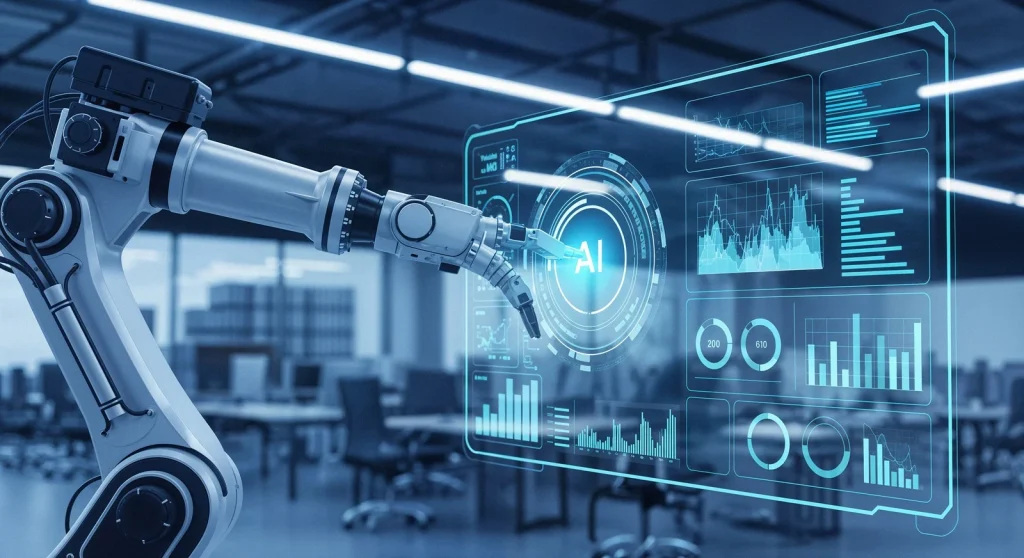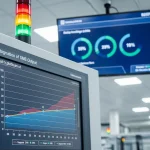The silence. That’s the first sign of trouble. The familiar, productive hum of the plant floor suddenly ceases, replaced by an unnerving quiet and the dreaded glow of a red light on the control panel. Every plant manager knows this feeling in their gut: another unplanned shutdown. Another frantic scramble for the maintenance team, another shattered production schedule, and another costly hit to the bottom line.
For decades, we’ve treated our most critical assets like black boxes. We run them until they break (Reactive Maintenance) or we service them on a rigid schedule, often replacing parts that have months of healthy life left (Preventive Maintenance). Both are fundamentally flawed strategies rooted in a single problem: we are operating in the dark.
But what if you could hear the machine’s whisper before it screams? What if you could see the hairline fracture in the data before it becomes a catastrophic failure in the steel? This isn’t science fiction. This is the new reality of plant operations, powered by Artificial Intelligence (AI) and Machine Learning (ML).
Contents
The Paradigm Shift
The core of this transformation lies in a simple but profound shift in thinking. We must stop treating maintenance as an event dictated by a calendar and start seeing it as a continuous conversation with our equipment.
Every motor, pump, press, and turbine in your facility is constantly generating a torrent of data; it’s operational heartbeat: vibration signatures, temperature fluctuations, acoustic patterns, power consumption, and fluid pressures. For years, this data was either ignored or only glanced at in isolation. It was noise.
AI and Machine Learning provide the universal translator. As highlighted by thought leaders from IBM to AspenTech, these technologies can sift through millions of data points in real-time, discerning subtle patterns that are invisible to the human eye. They learn the unique “healthy” signature of each asset and can therefore detect the faintest deviation that signals impending trouble.
The Mechanics of Predictive Maintenance
This isn’t magic; it’s data science in action. The process, known as Predictive Maintenance, moves you from a state of ignorance to one of foreknowledge.
It starts with data from the Industrial Internet of Things (IIoT). Smart sensors, which are more affordable and robust than ever, are fitted to critical equipment to capture this live operational data. This data stream is then fed into a machine learning model. Think of this model as a highly trained specialist who has studied every failure mode of that specific type of equipment.
The model doesn’t just look at one variable; it correlates dozens. It might learn that a 2% increase in vibration, combined with a 4°C rise in casing temperature and a specific acoustic frequency, has preceded a bearing failure 95% of the time in the past.
The result is no longer a vague warning light. It’s a precise, actionable insight delivered days or even weeks in advance:
- Instead of: “Pump 7 has failed.”
- You get: “Abnormal harmonic signature detected in Pump 7. Analysis indicates 89% probability of seal failure within the next 200 operating hours. Recommend scheduling replacement during the planned shutdown on Friday.”
This is the power of moving from reacting to predicting. As Rockwell Automation points out, this capability is a cornerstone of Industry 4.0 and the single biggest lever you can pull to improve Overall Equipment Effectiveness (OEE).
Beyond Uptime to Total Operational Intelligence
The true power of predictive intelligence is that it refuses to stay confined to the maintenance department. Stopping a machine from breaking is a critical first step, but the data-driven foresight you gain radiates outward, fundamentally reshaping how the entire organization functions, strategizes, and wins. Reducing unplanned downtime is not the end goal; it is the catalyst for achieving total operational intelligence.
From a Costly Warehouse to a Strategic Supply Chain
Take a walk through your current spare parts warehouse. It’s likely less of a strategic asset and more of a high-cost museum of “just-in-case” components. This is the direct result of operating in the dark. Without knowing when a part might fail, you are forced to hoard expensive spares, tying up enormous amounts of working capital and occupying valuable space. The predictive alert—”Abnormal harmonic signature detected in Pump 7; 89% probability of seal failure within 200 operating hours”—changes everything. It transforms your MRO (Maintenance, Repair, and Operations) strategy from reactive hoarding to a lean, surgical, just-in-time supply chain. The alert triggers an automated procurement workflow, ensuring the right part arrives exactly when it’s needed, dramatically reducing inventory costs and freeing up cash flow for growth and innovation.
From Fragile Schedules to Production Certainty
For a production planner, an unexpected shutdown is a grenade thrown into a carefully constructed plan. The result is chaos: frantic rescheduling, expensive overtime, expedited shipping costs to appease frustrated customers, and a tangible erosion of market trust. When asset availability is a gamble, your production schedule is merely a fragile promise. By making maintenance predictable, AI provides the invaluable gift of production certainty. Planners can treat uptime as a reliable constant, not a volatile variable. This allows for more accurate forecasting, smoother resource allocation, and the ability to confidently commit to customer deadlines. Your entire operation shifts from being a house of cards, vulnerable to the next gust of wind, to a resilient fortress built on a foundation of data.
From Reactive Safety to Proactive Risk Mitigation
A catastrophic equipment failure is not just a financial and operational disaster; it is a significant safety hazard. Traditionally, many safety protocols are reactive, learning from incidents after they have already occurred. Predictive intelligence fundamentally flips this dynamic, making it one of the most powerful proactive safety tools at your disposal. The same data signature that predicts a mechanical fault is also predicting—and therefore helping to prevent—a potential safety incident. By foreseeing and preventing the conditions that lead to high-energy failures, you are actively mitigating operational risk and creating a demonstrably safer environment for your team. This goes beyond compliance; it fosters a culture of safety, improves morale, and can positively impact insurance liabilities.
From Guesswork to Data-Driven Capital Planning
The multi-million-dollar question of when to repair versus when to replace a major asset is often answered with a blend of manufacturer guidelines, asset age, and gut instinct. AI-driven asset lifecycle management replaces this guesswork with data-backed clarity. By providing a true understanding of an asset’s health and its Remaining Useful Life (RUL), these systems enable strategic capital planning. You can now confidently make decisions. This ensures your capital is invested for maximum impact, extending the life of healthy equipment and prioritizing investment where it’s needed most.
This is the ultimate ripple effect: maintenance, procurement, operations, finance, and safety all begin to speak the same data-driven language. The entire plant starts to operate as a single, intelligent, and synchronized system, driven by foresight instead of reacting to failure.
Conclusion
The era of flying blind is over. The technology to illuminate your entire production process is no longer an emerging concept; it is a mature, proven, and accessible tool. The choice is simple: continue to let equipment failures dictate your schedule and your profits, or start listening to what your assets are telling you. The conversation is already happening on your plant floor. It’s time to join in.
Achieving this level of total operational intelligence may seem like a monumental task. The principles are clear, but the path from raw sensor data to a fully predictive and synchronized operation can feel complex. This journey from theory to tangible ROI doesn’t have to be navigated alone.
This is precisely where Epsum Labs steps in. We are specialists in industrial intelligence, engineering solutions that are purpose-built for the high-stakes environment of a processing plant.
Our AI-powered Asset Performance Management (APM) platform is designed to be the universal translator for your equipment. We connect directly to your existing data sources: your SCADA, PLCs, and historians—to:
- Deploy Advanced Predictive Models: Our machine learning algorithms are trained to recognize the unique failure signatures of your critical assets, providing you with specific, actionable warnings weeks or even months in advance.
- Enable Intelligent Workflows: We go beyond mere alerts. Our platform can initiate a cascade of value-driven actions, automatically generating a maintenance work order, flagging the risk to the production schedule, and informing the MRO team to ensure parts are available.
- Deliver Total Operational Visibility: By integrating asset health with production data, we provide a holistic view of your operations. This empowers your managers to make data-backed decisions not just on maintenance, but on capital planning, resource allocation, and risk management.
We don’t just hand you a piece of software. We partner with your team to deploy a system that empowers your engineers and operators, combining their invaluable domain expertise with our AI’s analytical power.
Stop waiting for the costly silence of a shutdown. Start listening to the valuable conversation your equipment is having every second.
Contact Epsum Labs today to schedule a demonstration and discover how we can help you translate your plant’s hidden data into unparalleled reliability and profitability.




